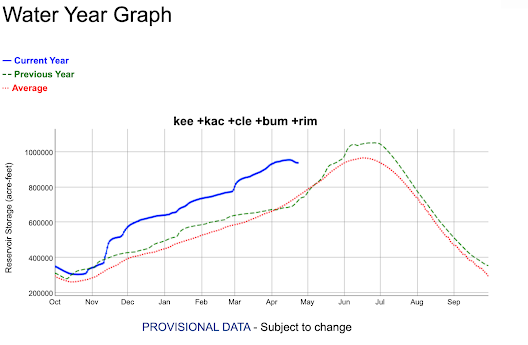Is a large portion of Washington State in extreme drought?
In a few previous blogs, I have criticized some of the media--such as the Seattle Times--for misinforming the public about extreme weather events.
Unfortunately, hypsters in the media have had help from those in government and academia, and there are few better examples than the latest claims about severe drought continuing in Washington State.
A case in point is the latest official Drought Monitor graphic for Washington State produced by the U.S. Department of Agriculture (see below). According to their analysis, about half of the state is in moderate drought, roughly a quarter is in severe drought, and about 10% is in EXTREME drought.
Do actual observations and climate data indicate extreme drought over eastern Washington?
The answer is clearly no. But you decide for yourself after reviewing the data.
Snowpack
Let's start with snowpack, and we are late enough in the season that the current snowpack tells us a lot about water availability this summer. The latest official snowpack numbers for Washington State are extremely encouraging--generally over 100% of normal, with lowest percentage of normal (Lower Yakima) being a reasonable healthy 78%.
Predicted River Flow Levels
Let's check both the critical rivers supplying water for the "extreme drought" region: the Yakima and Columbia.
The reservoirs of the Yakima River are WAY, WAY above normal (see the latest graph of storage versus normal, below). Red is normal, blue indicates this year's values.
Amazing. The reservoirs right now are as full as they normally are in June after the spring snowmelt. With a big snowpack in place, there will be more than enough water for agriculture around the Yakima Valley.
The NOAA/NWS River Forecast Center in Portland has released its latest forecast of river levels in 120 days (middle of August), as shown below. The Yakima is projected to be at 140-150% of normal and the Columbia will be around 100% of normal.
Soil Moisture
Well, what about soil moisture outside of irrigated areas? Soil moisture is certainly important for dryland wheat farmers in the Palouse area.
NASA has a satellite-based system to analyze soil moisture called GRACE. Below are the latest values nationally, with a blow-up for Washington below. Blue indicates ABOVE NORMAL values. Note blue over much of the extreme drought area. Other soil moisture analyses are similar.
Precipitation
Meteorologists like to look at the water year precipitation, the total precipitation from October 1 to the present, to provide an integrated view of winter moisture. For Washington State (see below), the water year was quite wet from the Cascades crest westward and near normal (light green and yellow) over eastern Washington.
But with all the talk of climate change and unprecedented "extreme drought", let's get a historical perspective.
Below is the water year precipitation (October 1-April 24th) for Yakima, WA since 1945. This year is slightly on the dry side, by many years (roughly two dozen) have been as dry or drier. Hardly exceptional.
Since there is concern about the unirrigated dryland wheat farms in the Palouse, here is the same graphic for Pullman. Pretty much near normal this year.
You will notice that there is little or no long-term trend in the precipitation record over the past 75 years....that is important. Eastern Washington has not been getting progressively drier under global warming.
The Bottom Line
The essential message is that weather and climate data do not support the claims of extreme or severe drought in eastern Washington this year.
There is no expectation of water problems over or near the Columbia Basin. The Drought Monitor graphics, which are created subjectively, are sufficiently problematic and deficient that they should not be considered or applied to any serious decision making.
The media loves apocalyptic and scary graphics for obvious reasons, but using these graphics to misinform the public is problematic at best and unethical at worst.
Finally, I should note that the big issue last summer was the extended extreme heatwave in late June. There is no reason to expect a repeat of that extraordinary, once in several hundred year, event.








.png)
.png)




Comments
Post a Comment